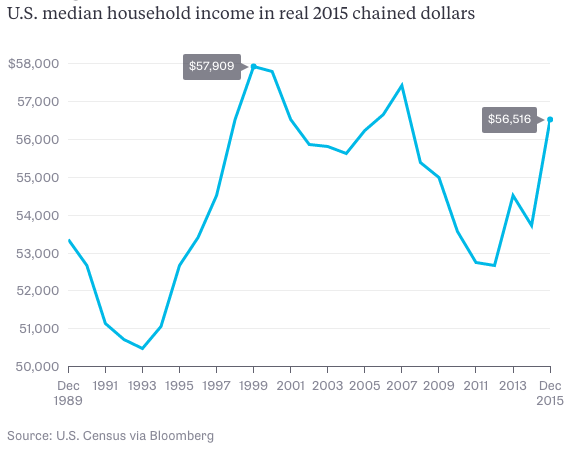During the past two years, we have seen signs that wage pressure is building as the economic recovery grinds on. Enough evidence has now accumulated to suggest that it is already happening.
The latest data, courtesy of the Census Bureau, which released its annual update on incomes and poverty yesterday, showed that median household income increased a whopping 5.2 percent in 2015 to an inflation-adjusted $56,516. As the New York Times, noted, it was “the largest single-year increase since record-keeping began in 1967.”
Some killjoys will note that median household income was $57,909 in 1999. That’s true, but the dot-com crash, housing bust and the credit crisis managed to cut that a lot. Median incomes fell 2.59 percent from 2000 to 2004, before almost rebounding to the pre-crisis peak. After 2007, the collapse was greater — a 4.94 percent drop that bottomed in 2013. You can see the changes in the chart below:
Ignore the naysayers; the most recent numbers were a huge positive surprise, showing that incomes for all Americans are rising in a meaningful way. Unlike in recent years, when much of the gains went to an increasingly narrow group at the top of the economic strata, last year’s improvements were broad and deep. “Gains were spread across the income spectrum and by race, while women’s earnings inched closer to men’s,” Bloomberg reported.
This is yet more evidence of a job market that, as we previously noted, is not getting weaker but stronger — despite the occasional disappointing number.
Of particular surprise to many was that the strongest gains were found among the lowest earners. To what shall we attribute these gains? Four things deserve most of the credit:
More people working: The big year-over-year change in employment, with almost 2.5 million more Americans working now than a year earlier, contributed to a meaningful change in total household income.
Corporate pay increases: Some of the U.S.’s largest employers, such asMcDonald’s and Wal-Mart, have played a significant role in raising incomes at the lower end of the income distribution. Wal-Mart in particular made substantial increases in wages for its lowest-paid employees. These increases stand in sharp contrast to the company’s pay policies of just a few years ago. Note that the increases are not just a public-relations effort, but due to the competitive labor environment; higher pay is needed to recruit and retain workers (and because workers demoralized by the low pay and unappealing employment conditions were hurting the shopping experience for Wal-Mart customers).
Minimum wage laws: Pay increases aren’t just voluntarily; after many years of little change in state and local minimum wage laws, increasesmandated by legislation are kicking in. That means the lowest-paid workers have seen pay rise in a number of cities and states.
Economic cycle: We are now in the latter stages of an economic recovery. Typically, we see wage pressure and inflation at some point in the cycle, although usually much earlier than this. But this isn’t the typical postwar recovery — it is a recovery from a financial crisis. These rebounds are longer and slower than others, as excesses of the credit boom must be worked off. The deleveraging process takes a long time.
The latest data is unequivocally good for households; what investors need to do is consider what this might mean more broadly. Rising incomes have ramifications for inflation, Federal Reserve policy, interest rates, retail spending, auto sales and residential real estate; they might even play a part in the presidential election.
More than seven years have passed since the last bear market and the Great Recession ended. The recovery has been slow and fitful, and hasn’t always been very convincing for many Americans. This improvement was a long time coming. Greet it with open arms.
Originally: Income Liftoff Shows the Recovery Is Real



What's been said:
Discussions found on the web: